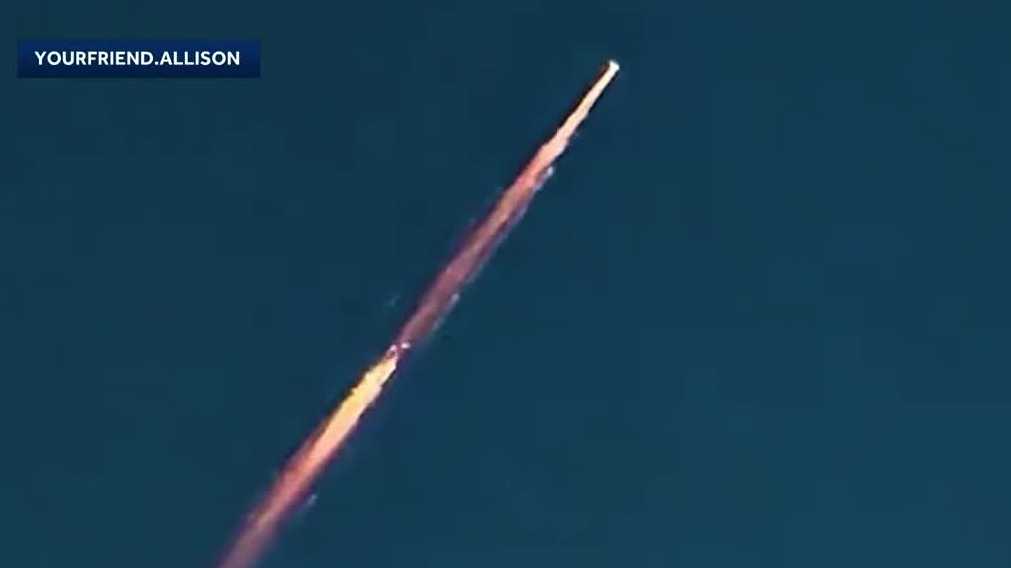A fiery streak blazing across the night sky caught the attention of skywatchers over the weekend, leaving many wondering what exactly they had seen. Experts say the phenomenon likely occurred as debris from a Chinese Long March 3B Third stage (the upper component of a Chinese heavy lift launch vehicle) descended through Earth’s atmosphere, creating a brilliant fireball visible for miles.How it happensWhen an object from space enters the atmosphere, it travels at tremendous speed, often tens of thousands of miles per hour. As it slams into thicker air, friction and compression generate intense heat, sometimes reaching several thousand degrees. That heat causes the surface of the object to erode and vaporize, producing the bright glowing trail that we perceive as a fiery streak across the sky.The flame seen across the morning sky on Nov. 8 was created by air molecules in front of the debris rapidly compressing, forming a shockwave and heating to plasma temperatures. Both the air and the object’s vaporized material emit light, creating the glowing path that streaked across the sky.Events like these are not uncommon. NASA and space agencies around the world track thousands of pieces of orbital debris that regularly reenter the atmosphere. Most burn up harmlessly, providing a dazzling show for anyone lucky enough to look up at the right moment.Depending on the source, the cause could vary.Meteors, often called shooting stars, are small fragments of rock or metal from space. When they burn up in the atmosphere, they create short, bright flashes of light lasting only seconds.Manmade space debris, such as broken satellites or rocket stages, can also reenter Earth’s atmosphere. As these objects burn up, they often break apart, producing multiple glowing fragments that move more slowly than meteors but still light up the sky in spectacular fashion.
ORLANDO, Fla. —
A fiery streak blazing across the night sky caught the attention of skywatchers over the weekend, leaving many wondering what exactly they had seen.
Experts say the phenomenon likely occurred as debris from a Chinese Long March 3B Third stage (the upper component of a Chinese heavy lift launch vehicle) descended through Earth’s atmosphere, creating a brilliant fireball visible for miles.

WESH 2 News
Fireball in Central Florida skies on Nov. 8
This content is imported from Twitter.
You may be able to find the same content in another format, or you may be able to find more information, at their web site.
The Chinese rocket Chang Zheng 3B No. Y67 was launched on 2019 Dec 16 to put two Beidou sats in orbit; it reentered at 1120 UTC over the Cape Canaveral region https://t.co/GPoSyqzGOl
— Jonathan McDowell (@planet4589) November 8, 2025
How it happens
When an object from space enters the atmosphere, it travels at tremendous speed, often tens of thousands of miles per hour. As it slams into thicker air, friction and compression generate intense heat, sometimes reaching several thousand degrees. That heat causes the surface of the object to erode and vaporize, producing the bright glowing trail that we perceive as a fiery streak across the sky.
The flame seen across the morning sky on Nov. 8 was created by air molecules in front of the debris rapidly compressing, forming a shockwave and heating to plasma temperatures. Both the air and the object’s vaporized material emit light, creating the glowing path that streaked across the sky.
Events like these are not uncommon. NASA and space agencies around the world track thousands of pieces of orbital debris that regularly reenter the atmosphere. Most burn up harmlessly, providing a dazzling show for anyone lucky enough to look up at the right moment.
Depending on the source, the cause could vary.
Meteors, often called shooting stars, are small fragments of rock or metal from space. When they burn up in the atmosphere, they create short, bright flashes of light lasting only seconds.
Manmade space debris, such as broken satellites or rocket stages, can also reenter Earth’s atmosphere. As these objects burn up, they often break apart, producing multiple glowing fragments that move more slowly than meteors but still light up the sky in spectacular fashion.

